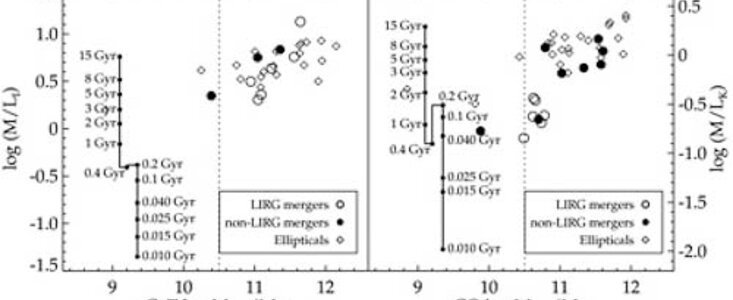Underweight or Blinded by Youth? Finding the True Mass of Galaxy Mergers
11 Marzo 2010
Galaxies are the building blocks of the universe, so accounting for their formation is an essential problem in astronomy. Most galaxies are either spiral or elliptical, with the latter tending to be larger and more massive. One suggestion that is grounded in fundamental measurements of the universe as a whole is that merging spiral galaxies form elliptical galaxies. A way to test the predictions of this merger hypothesis is to observe examples of galaxy merging in process. Barry Rothberg and Jacqueline Fischer of the Naval Research Laboratory (US) have done that, drawing important conclusions about the objects they observed and the techniques astronomers use to measure them.
One critical property of a galaxy is its mass. The motion of stars is sensitive to the gravitational effect of the mass, so measuring the stellar motion can yield a galaxy's mass. Observations of characteristic features in the spectra of stars are sensitive to this motion. Specifically, measurement of CO at near-infrared wavelengths is a common diagnostic, especially in dusty luminous and ultraluminous infrared galaxies (LIRGs and ULIRGs). A surprising aspect of past near-IR studies of merging galaxies is that the resulting elliptical galaxies would have relatively low mass, while previous optical studies by Rothberg using the calcium II triplet at 0.85µm show that they would have large masses. Is there a fundamental problem with using the CO measurements for all galaxies, or is something strange happening only in the LIRGs and ULIRGs that had been studied? As Rothberg says, "Either possibility would have a significant impact on galaxy dynamical studies. The only instrument that could answer this question definitively was GNIRS (Gemini Near-Infrared Spectrograph), because of the unique combination of spectral and spatial resolution and the need for an 8-meter mirror to gather enough light."
In the new work, Rothberg and Fischer find that IR-luminous mergers appear younger and less massive in the near-IR but indistinguishable from old, massive ellipticals at optical wavelengths (geminiann10007a). The fundamental measurement of these two diagnostics (the velocity dispersion) is different in the LIRGs, where CO shows smaller velocity dispersion and therefore indicates smaller mass. Normal elliptical galaxies and merger remnants that are not IR-luminous, however, do not show any significant difference between the optical and near-IR measurements (geminiann10007b). GNIRS provided the critical observations to show that CO measurements cannot be used to determine the mass of LIRGs and ULIRGs.
Why are these IR-luminous merging galaxies different, and what do their CO measurements mean? The strong infrared emission from these systems arises in the dusty environments of recent bursts of star formation. The CO measurements are sensitive to these younger stars, and they even show a rotating disk of young stars in rotation curves. Thus, in these luminous IR galaxies, the CO does not probe the total mass of the merger remnant but traces the rotating young central stellar disk instead. Optical light cannot penetrate the dusty centers of these systems, so these central stellar disks do not affect the calcium II triplet diagnostic, and it measures the mass of the entire merger (geminiann10007c). After the merging systems have settled to become regular elliptical galaxies, however, they no longer exhibit the confusion of recent star formation and obscuring dust, so optical and infrared measurements are consistent with each other.
The complete results (published in the Astrophysical Journal 2010, Vol. 712, page 318) use data from the University of Hawaii 2.2 meter, Keck, and Hubble Space telescopes in addition to Gemini. GNIRS is currently being repaired, and it will be deployed on the Gemini North telescope later this year.




